Answered step by step
Verified Expert Solution
Question
1 Approved Answer
Capstone Project: Implement a Technical Solution for a Small Business Objectives Part 1: Gather information and determine customer requirements. Part 2: Gather system requirements. Part
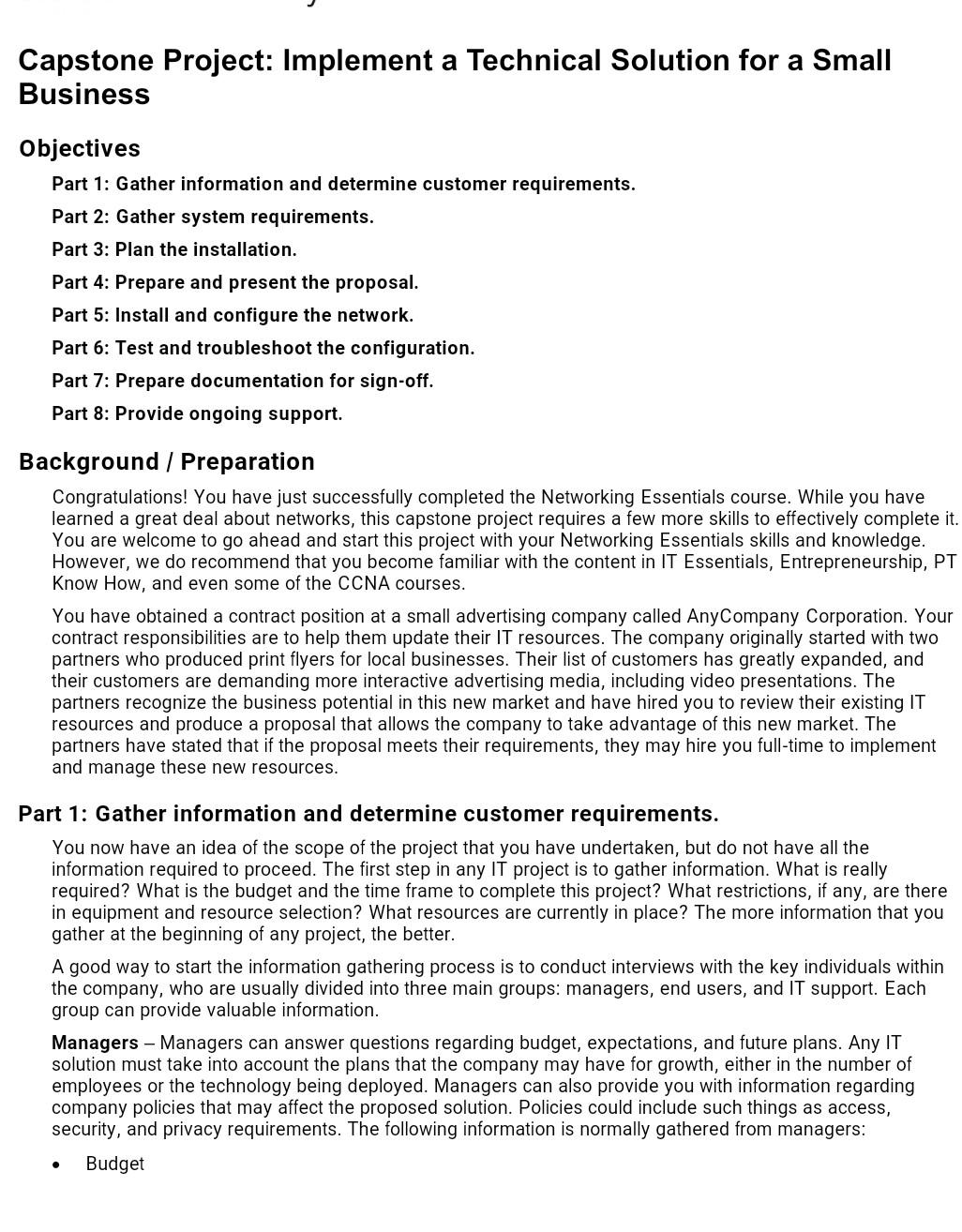
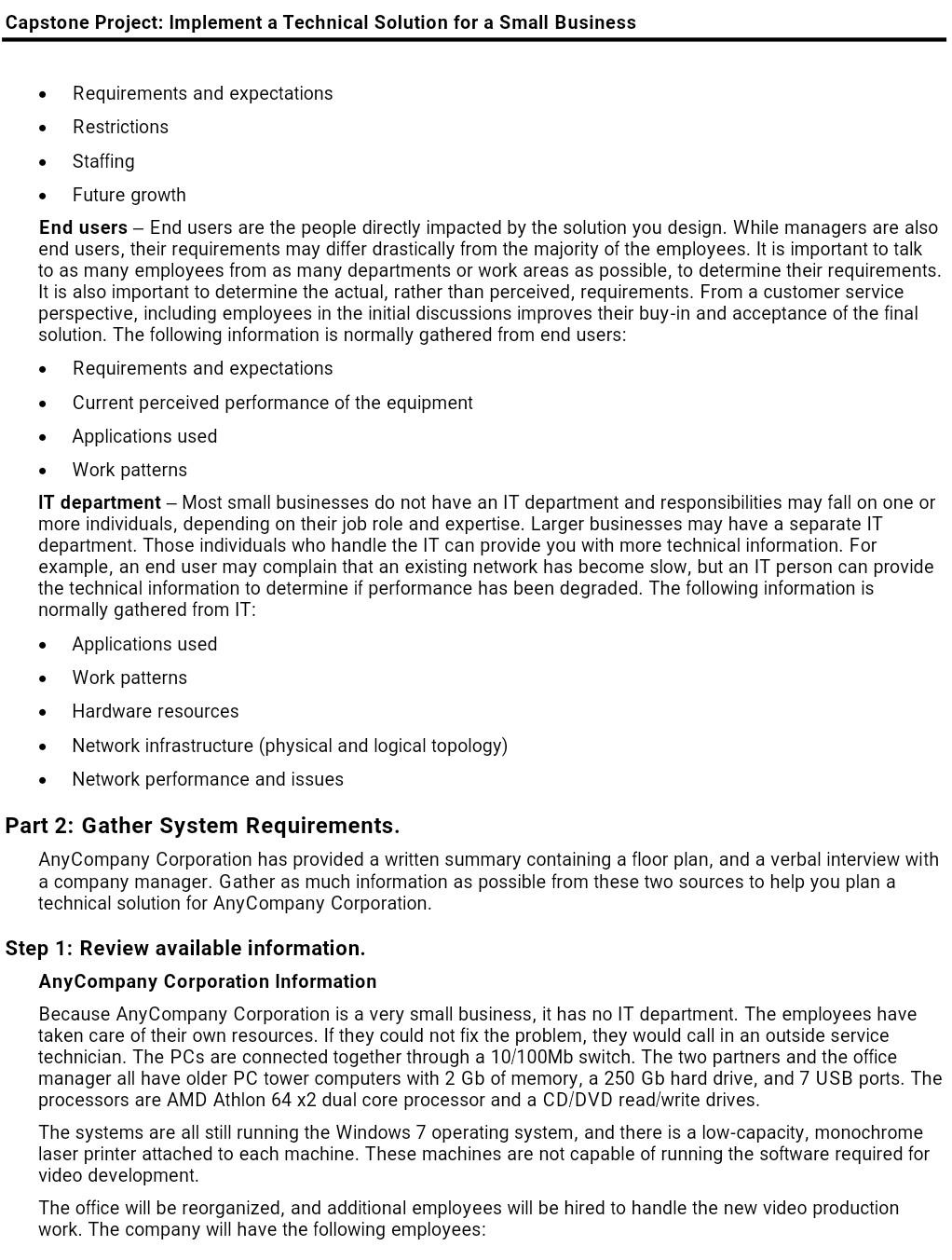
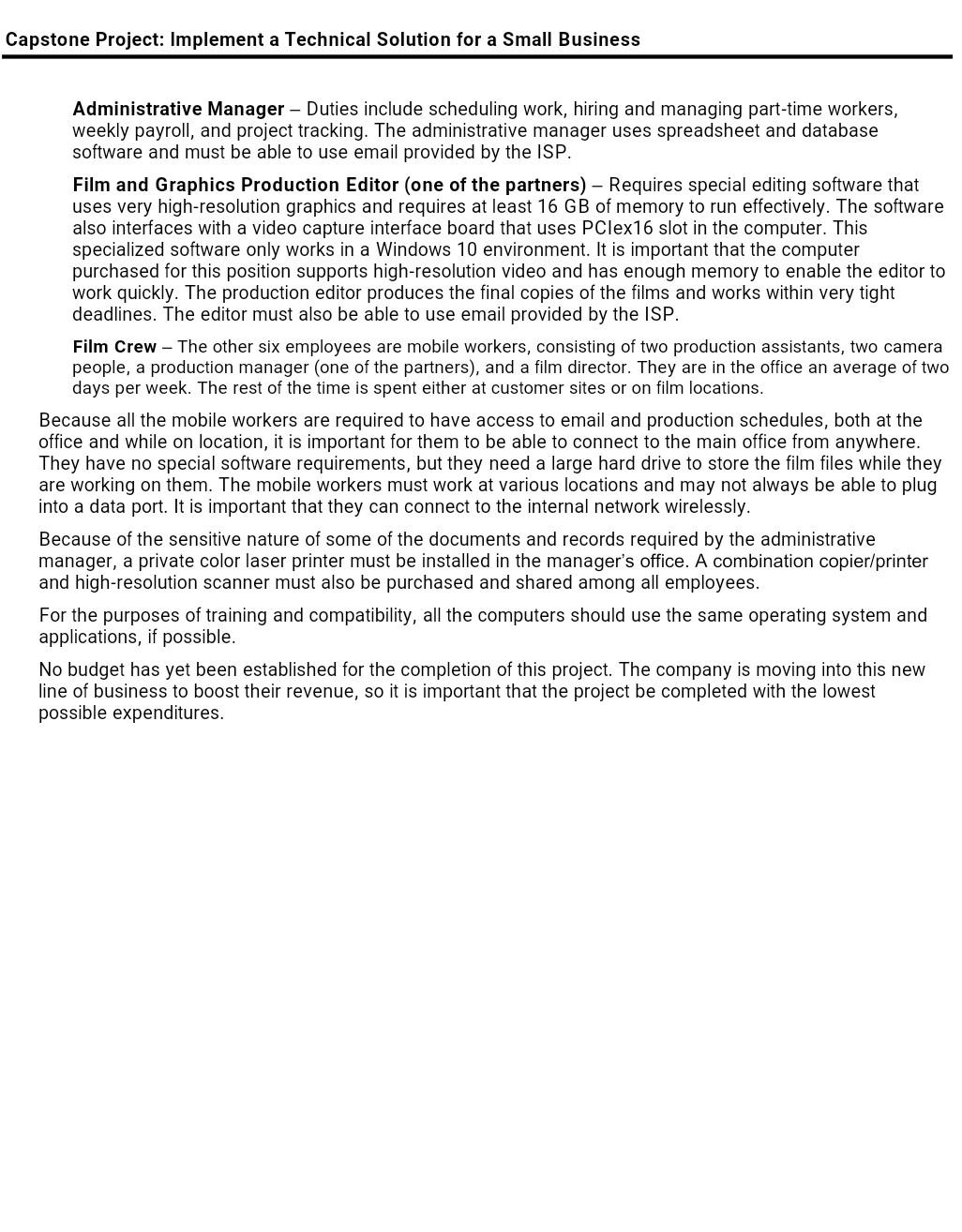
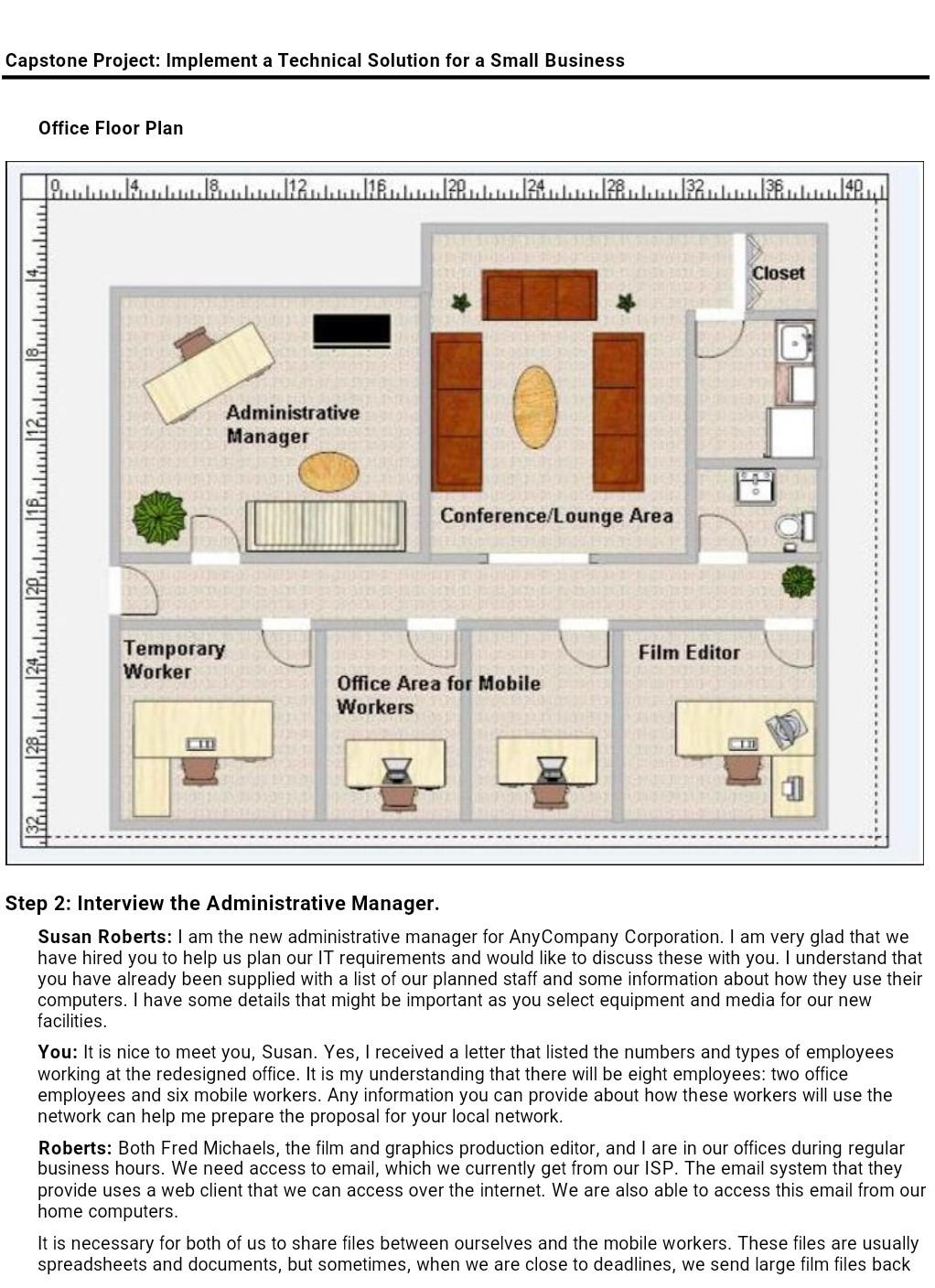
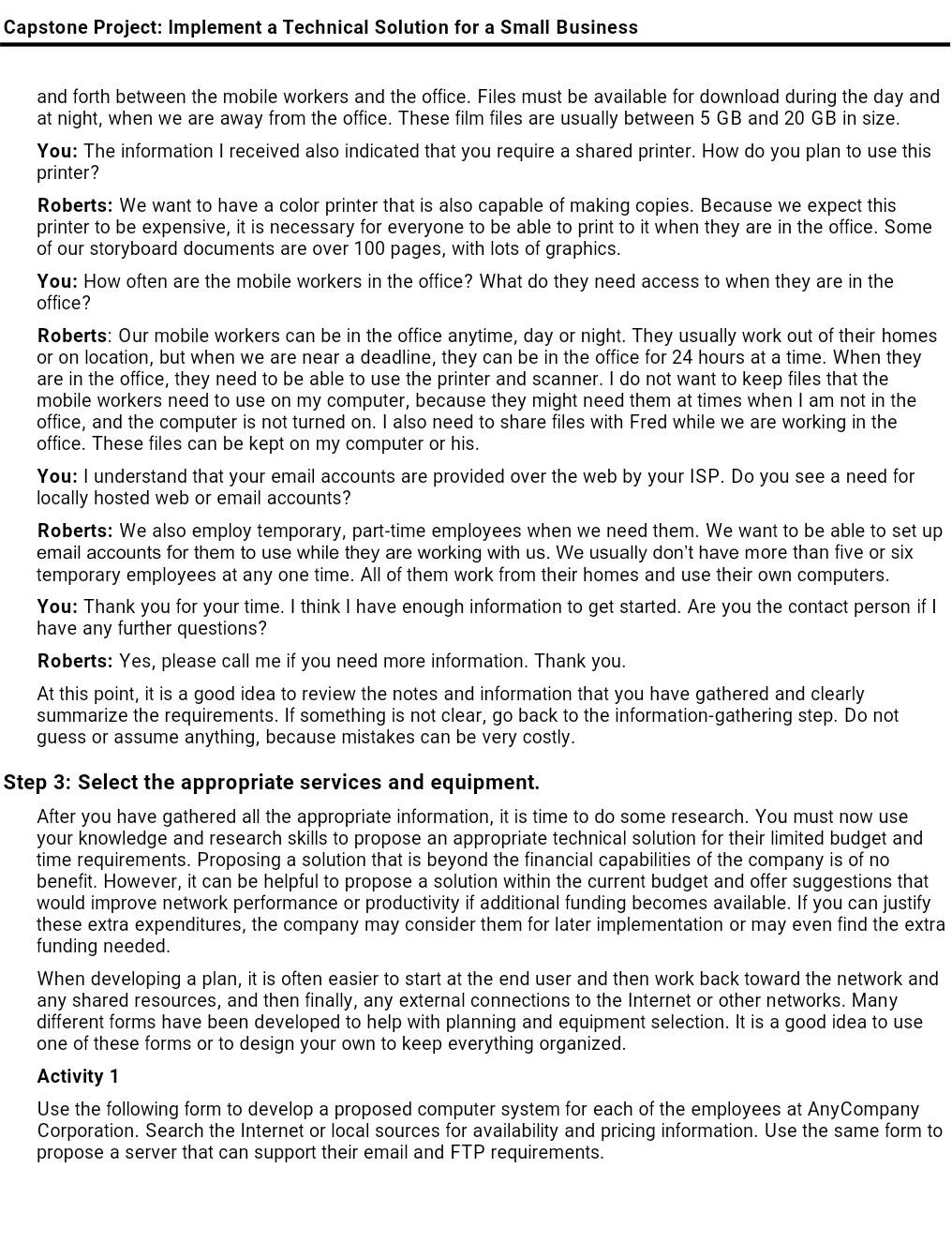

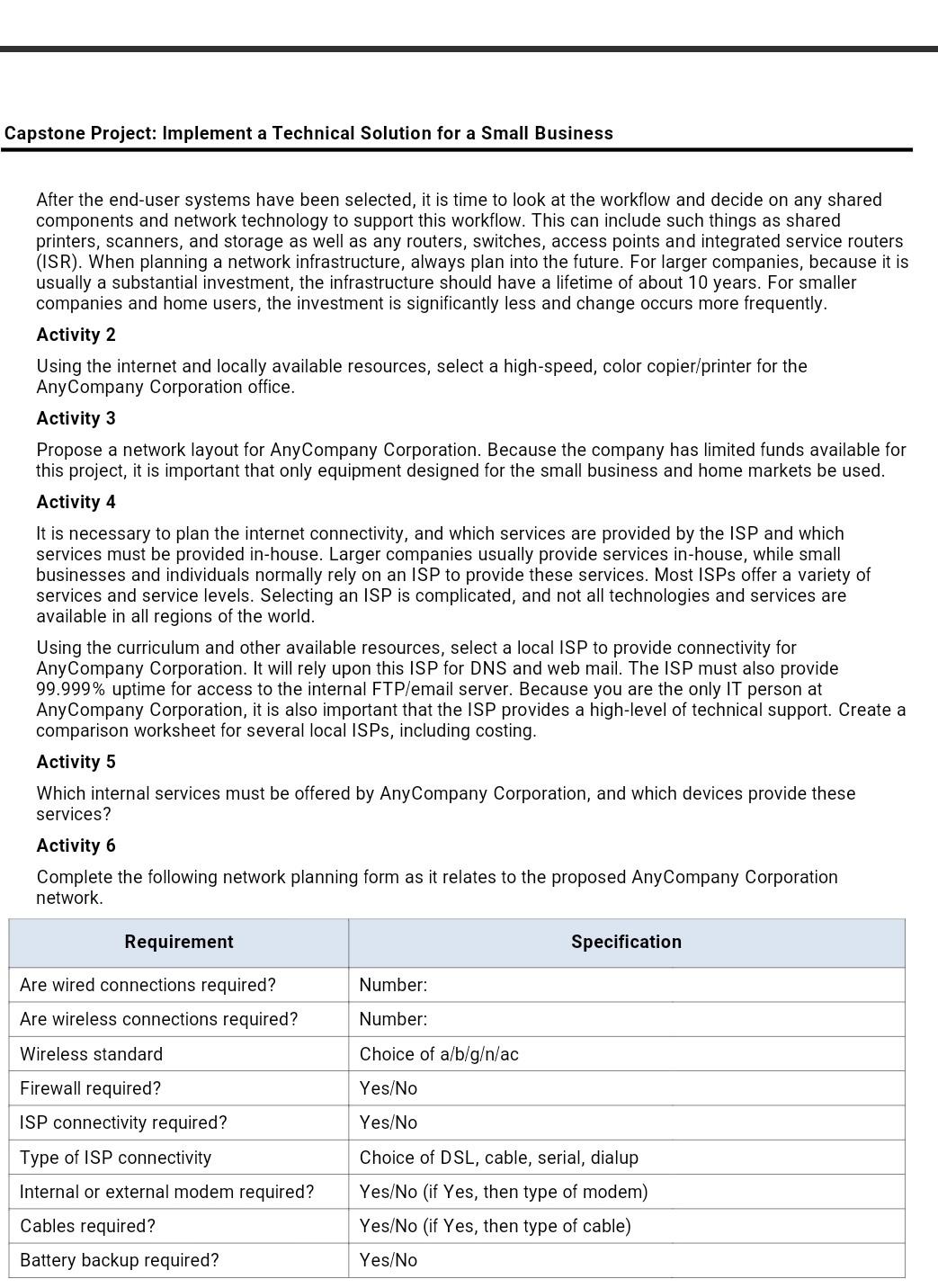
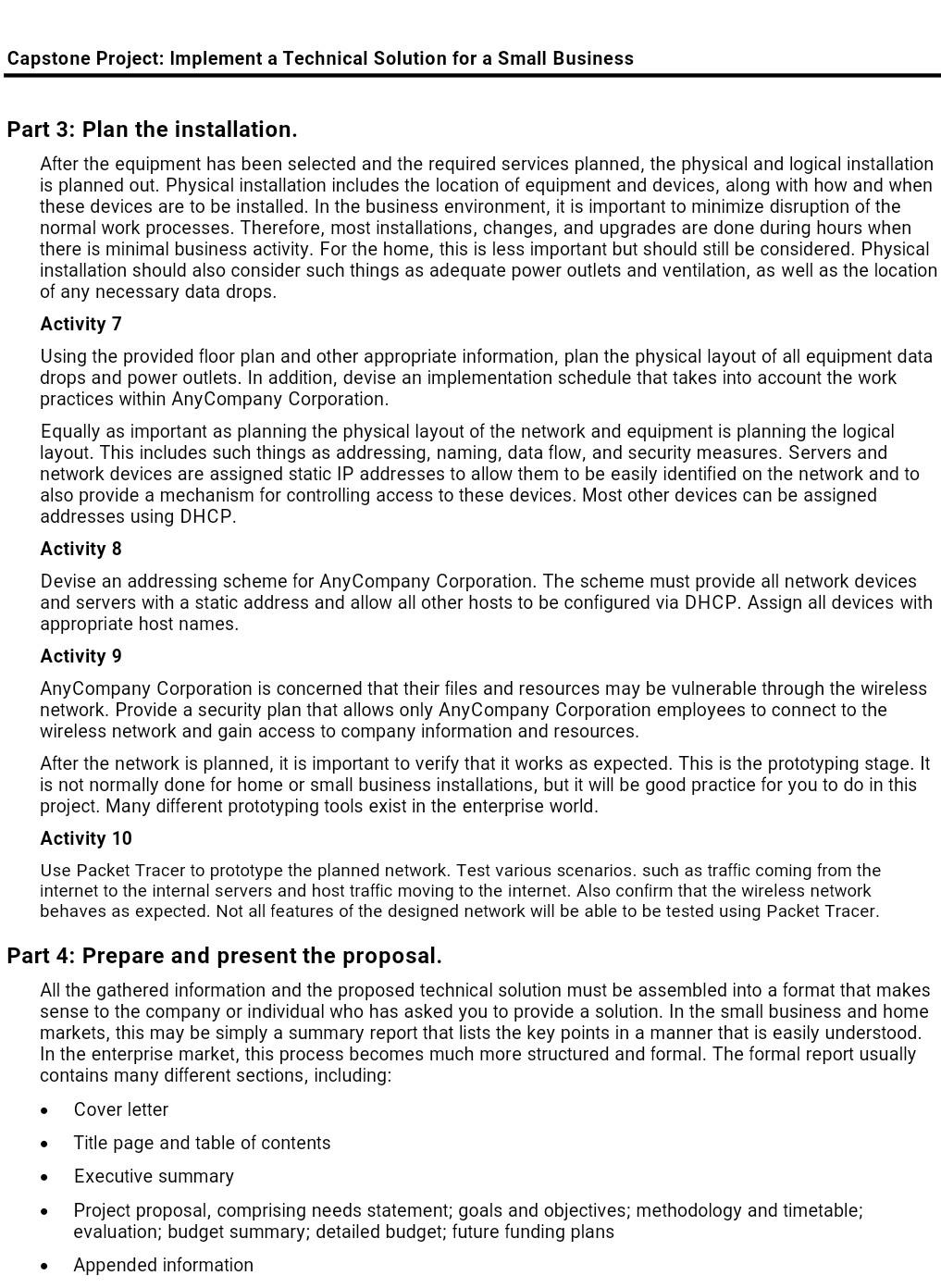
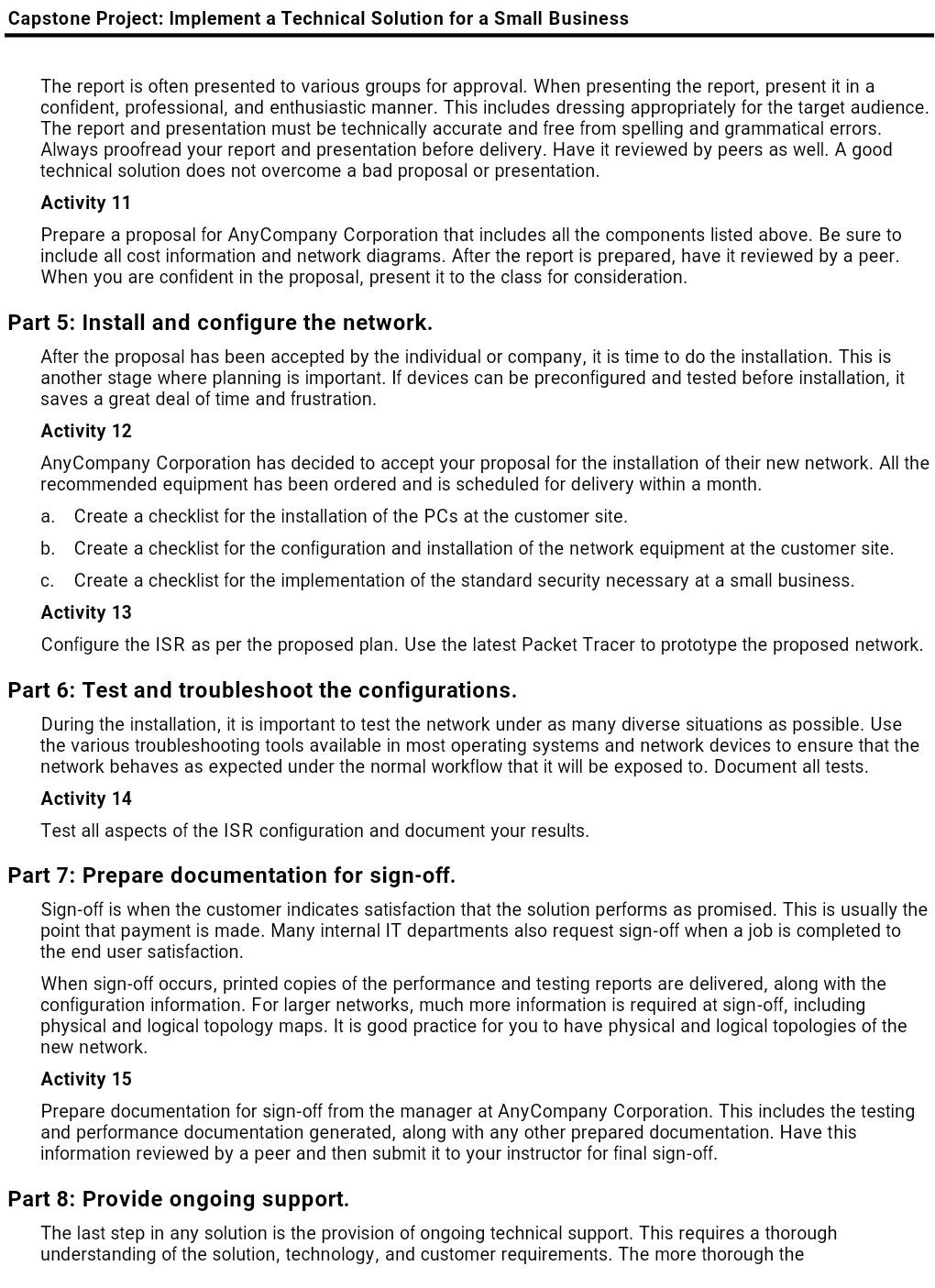
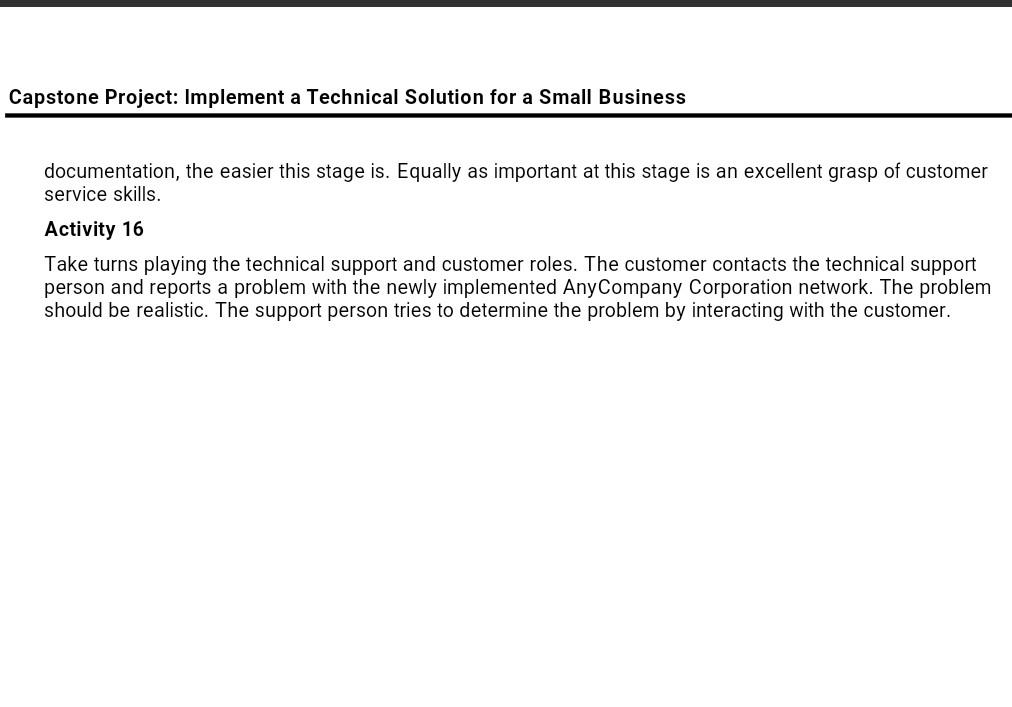
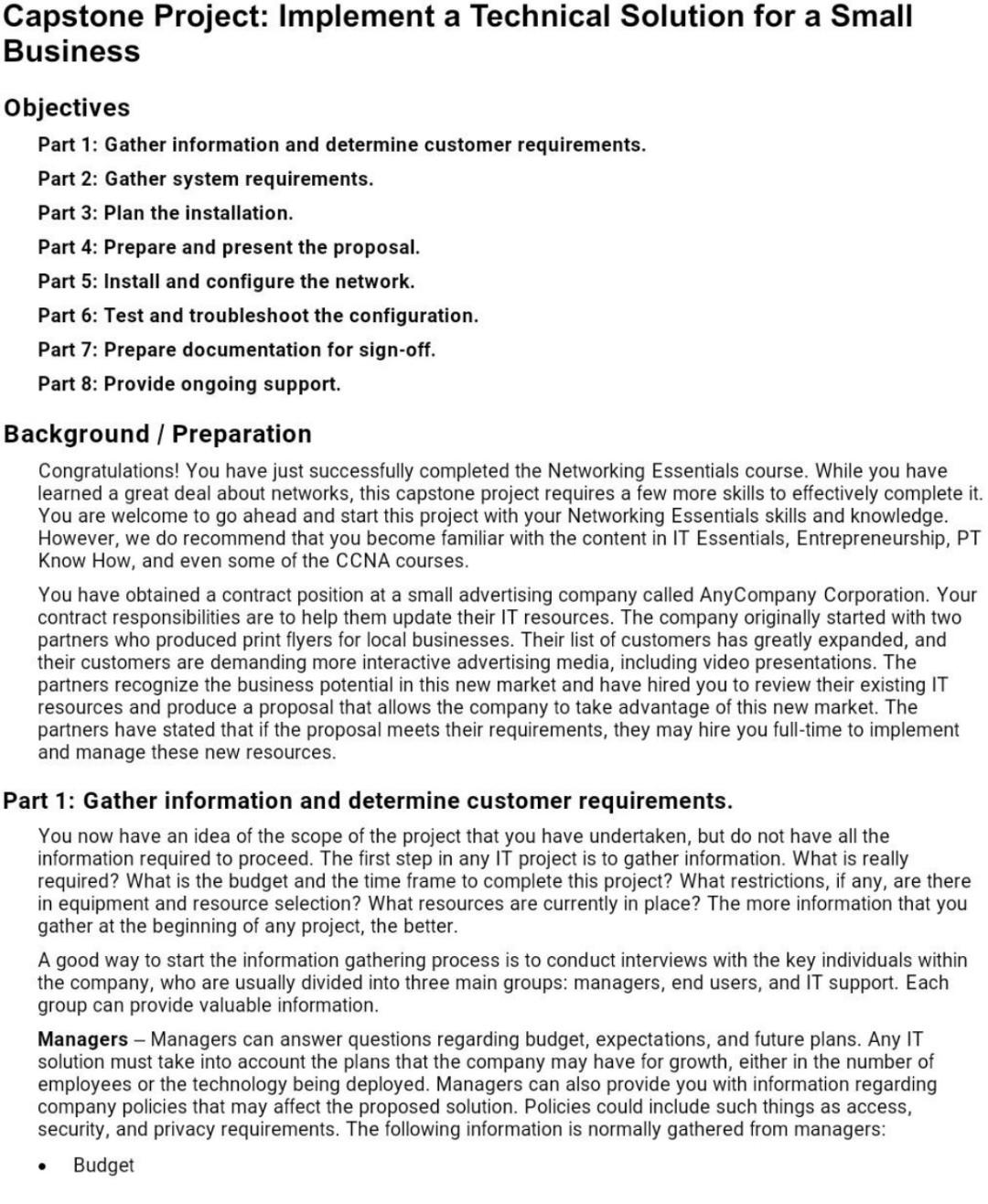
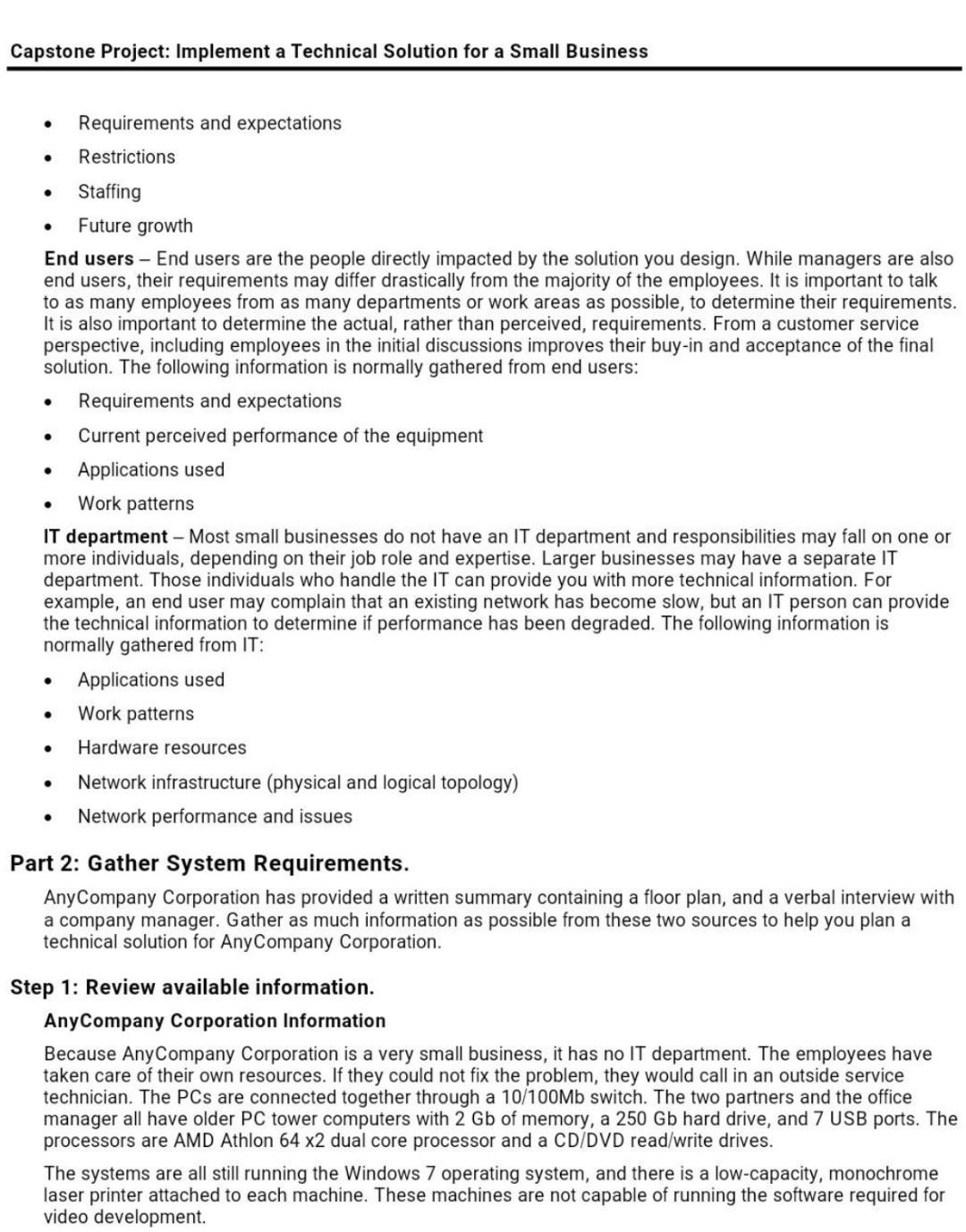
Capstone Project: Implement a Technical Solution for a Small Business Objectives Part 1: Gather information and determine customer requirements. Part 2: Gather system requirements. Part 3: Plan the installation. Part 4: Prepare and present the proposal. Part 5: Install and configure the network. Part 6: Test and troubleshoot the configuration. Part 7: Prepare documentation for sign-off. Part 8: Provide ongoing support. Background / Preparation Congratulations! You have just successfully completed the Networking Essentials course. While you have learned a great deal about networks, this capstone project requires a few more skills to effectively complete it. You are welcome to go ahead and start this project with your Networking Essentials skills and knowledge. However, we do recommend that you become familiar with the content in IT Essentials, Entrepreneurship, PT Know How, and even some of the CCNA courses. You have obtained a contract position at a small advertising company called Any Company Corporation. Your contract responsibilities are to help them update their IT resources. The company originally started with two partners who produced print flyers for local businesses. Their list of customers has greatly expanded, and their customers are demanding more interactive advertising media, including video presentations. The partners recognize the business potential in this new market and have hired you to review their existing IT resources and produce a proposal that allows the company to take advantage of this new market. The partners have stated that if the proposal meets their requirements, they may hire you full-time to implement and manage these new resources. Part 1: Gather information and determine customer requirements. You now have an idea of the scope of the project that you have undertaken, but do not have all the information required to proceed. The first step in any IT project is to gather information. What is really required? What is the budget and the time frame to complete this project? What restrictions, if any, are there in equipment and resource selection? What resources are currently in place? The more information that you gather at the beginning of any project, the better. A good way to start the information gathering process is to conduct interviews with the key individuals within the company, who are usually divided into three main groups: managers, end users, and IT support. Each group can provide valuable information. Managers - Managers can answer questions regarding budget, expectations, and future plans. Any IT solution must take into account the plans that the company may have for growth, either in the number of employees or the technology being deployed. Managers can also provide you with information regarding company policies that may affect the proposed solution. Policies could include such things as access, security, and privacy requirements. The following information is normally gathered from managers: Budget . Capstone Project: Implement a Technical Solution for a Small Business . Requirements and expectations Restrictions Staffing . . Future growth . . . End users - End users are the people directly impacted by the solution you design. While managers are also end users, their requirements may differ drastically from the majority of the employees. It is important to talk to as many employees from as many departments or work areas as possible, to determine their requirements. It is also important to determine the actual, rather than perceived, requirements. From a customer service perspective, including employees in the initial discussions improves their buy-in and acceptance of the final solution. The following information is normally gathered from end users: Requirements and expectations Current perceived performance of the equipment Applications used Work patterns IT department - Most small businesses do not have an IT department and responsibilities may fall on one or more individuals, depending on their job role and expertise. Larger businesses may have a separate IT department. Those individuals who handle the IT can provide you with more technical information. For example, an end user may complain that an existing network has become slow, but an IT person can provide the technical information to determine if performance has been degraded. The following information is normally gathered from IT: Applications used Work patterns O . Hardware resources Network infrastructure (physical and logical topology) Network performance and issues . Part 2: Gather System Requirements. Any Company Corporation has provided a written summary containing a floor plan, and a verbal interview with a company manager. Gather as much information as possible from these two sources to help you plan a technical solution for Any Company Corporation. Step 1: Review available information. Any Company Corporation Information Because Any Company Corporation is a very small business, it has no IT department. The employees have taken care of their own resources. If they could not fix the problem, they would call in an outside service technician. The PCs are connected together through a 10/100Mb switch. The two partners and the office manager all have older PC tower computers with 2 Gb of memory, a 250 Gb hard drive, and 7 USB ports. The processors are AMD Athlon 64 x2 dual core processor and a CD/DVD read/write drives. The systems are all still running the Windows 7 operating system, and there is a low-capacity, monochrome laser printer attached to each machine. These machines are not capable of running the software required for video development. The office will be reorganized, and additional employees will be hired to handle the new video production work. The company will have the following employees: Capstone Project: Implement a Technical Solution for a Small Business Administrative Manager Duties include scheduling work, hiring and managing part-time workers, weekly payroll, and project tracking. The administrative manager uses spreadsheet and database software and must be able to use email provided by the ISP. Film and Graphics Production Editor (one of the partners) - Requires special editing software that uses very high-resolution graphics and requires at least 16 GB of memory to run effectively. The software also interfaces with a video capture interface board that uses PClex16 slot in the computer. This specialized software only works in a Windows 10 environment. It is important that the computer purchased for this position supports high-resolution video and has enough memory to enable the editor to work quickly. The production editor produces the final copies of the films and works within very tight deadlines. The editor must also be able to use email provided by the ISP. Film Crew - The other six employees are mobile workers, consisting of two production assistants, two camera people, a production manager (one of the partners), and a film director. They are in the office an average of two days per week. The rest of the time is spent either at customer sites or on film locations. Because all the mobile workers are required to have access to email and production schedules, both at the office and while on location, it is important for them to be able to connect to the main office from anywhere. They have no special software requirements, but they need a large hard drive to store the film files while they are working on them. The mobile workers must work at various locations and may not always be able to plug into a data port. It is important that they can connect to the internal network wirelessly. Because of the sensitive nature of some of the documents and records required by the administrative manager, a private color laser printer must be installed in the manager's office. A combination copier/printer and high-resolution scanner must also be purchased and shared among all employees. For the purposes of training and compatibility, all the computers should use the same operating system and applications, if possible. No budget has yet been established for the completion of this project. The company is moving into this new line of business to boost their revenue, so it is important that the project be completed with the lowest possible expenditures. Capstone Project: Implement a Technical Solution for a Small Business Office Floor Plan E 13... 140 Closet Administrative Manager Conference/Lounge Area Temporary Worker Film Editor Office Area for Mobile Workers Step 2: Interview the Administrative Manager. Susan Roberts: I am the new administrative manager for Any Company Corporation. I am very glad that we have hired you to help us plan our IT requirements and would like to discuss these with you. I understand that you have already been supplied with a list of our planned staff and some information about how they use their computers. I have some details that might be important as you select equipment and media for our new facilities. You: It is nice to meet you, Susan. Yes, I received a letter that listed the numbers and types of employees working at the redesigned office. It is my understanding that there will be eight employees: two office employees and six mobile workers. Any information you can provide about how these workers will use the network can help me prepare the proposal for your local network. Roberts: Both Fred Michaels, the film and graphics production editor, and I are in our offices during regular business hours. We need access to email, which we currently get from our ISP. The email system that they provide uses a web client that we can access over the internet. We are also able to access this email from our home computers. It is necessary for both of us to share files between ourselves and the mobile workers. These files are usually spreadsheets and documents, but sometimes, when we are close to deadlines, we send large film files back Capstone Project: Implement a Technical Solution for a Small Business and forth between the mobile workers and the office. Files must be available for download during the day and at night, when we are away from the office. These film files are usually between 5 GB and 20 GB in size. You: The information I received also indicated that you require a shared printer. How do you plan to use this printer? Roberts: We want to have a color printer that is also capable of making copies. Because we expect this printer to be expensive, it is necessary for everyone to be able to print to it when they are in the office. Some of our storyboard documents are over 100 pages, with lots of graphics. You: How often are the mobile workers in the office? What do they need access to when they are in the office? Roberts: Our mobile workers can be in the office anytime, day or night. They usually work out of their homes or on location, but when we are near a deadline, they can be in the office for 24 hours at a time. When they are in the office, they need to be able to use the printer and scanner. I do not want to keep files that the mobile workers need to use on my computer, because they might need them at times when I am not in the office, and the computer is not turned on. I also need to share files with Fred while we are working in the office. These files can be kept on my computer or his. You: I understand that your email accounts are provided over the web by your ISP. Do you see a need for locally hosted web or email accounts? Roberts: We also employ temporary, part-time employees when we need them. We want to be able to set up email accounts for them to use while they are working with us. We usually don't have more than five or six temporary employees at any one time. All of them work from their homes and use their own computers. You: Thank you for your time. I think I have enough information to get started. Are you the contact person if I have any further questions? Roberts: Yes, please call me if you need more information. Thank you. At this point, it is a good idea to review the notes and information that you have gathered and clearly summarize the requirements. If something is not clear, go back to the information-gathering step. Do not guess or assume anything, because mistakes can be very costly. Step 3: Select the appropriate services and equipment. After you have gathered all the appropriate information, it is time to do some research. You must now use your knowledge and research skills to propose an appropriate technical solution for their limited budget and time requirements. Proposing a solution that is beyond the financial capabilities of the company is of no benefit. However, it can be helpful to propose a solution within the current budget and offer suggestions that would improve network performance or productivity if additional funding becomes available. If you can justify these extra expenditures, the company may consider them for later implementation or may even find the extra funding needed. When developing a plan, it is often easier to start at the end user and then work back toward the network and any shared resources, and then finally, any external connections to the Internet or other networks. Many different forms have been developed to help with planning and equipment selection. It is a good idea to use one of these forms or to design your own to keep everything organized. Activity 1 Use the following form to develop a proposed computer system for each of the employees at Any Company Corporation. Search the Internet or local sources for availability and pricing information. Use the same form to propose a server that can support their email and FTP requirements. Computer System Planning Form Job Role: Location: Component Recommendation Processor: (Manufacturer, Model, Speed) Memory: (Type, Amount) Hard Drive: (Type, Capacity) CD-ROM/DVD: (Read, Read/Write, Speed) USB Ports: (Number, Location) Video Card: (Manufacturer, Model, Video RAM Sound Card: (Manufacturer, Model) Modem: (Internal/External, Speed, Standard) Network Card(s): (Ethernet: speed, Wireless, Standard) Operating System: (Manufacturer, Version, Compatibility) Monitor: (Size, Resolution, Refresh Rate) Printer: (Manufacturer, Model, Type, Speed) Speakers: (Manufacturer, Model, Type) Internet Connection: (USB, Ethernet, Wireless) Capstone Project: Implement a Technical Solution for a Small Business After the end-user systems have been selected, it is time to look at the workflow and decide on any shared components and network technology to support this workflow. This can include such things as shared printers, scanners, and storage as well as any routers, switches, access points and integrated service routers (ISR). When planning a network infrastructure, always plan into the future. For larger companies, because it is usually a substantial investment, the infrastructure should have a lifetime of about 10 years. For smaller companies and home users, the investment is significantly less and change occurs more frequently. Activity 2 Using the internet and locally available resources, select a high-speed, color copier/printer for the Any Company Corporation office. Activity 3 Propose a network layout for Any Company Corporation. Because the company has limited funds available for this project, it is important that only equipment designed for the small business and home markets be used. Activity 4 It is necessary to plan the internet connectivity, and which services are provided by the ISP and which services must be provided in-house. Larger companies usually provide services in-house, while small businesses and individuals normally rely on an ISP to provide these services. Most ISPs offer a variety of services and service levels. Selecting an ISP is complicated, and not all technologies and services are available in all regions of the world. Using the curriculum and other available resources, select a local ISP to provide connectivity for Any Company Corporation. It will rely upon this ISP for DNS and web mail. The ISP must also provide 99.999% uptime for access to the internal FTP/email server. Because you are the only IT person at AnyCompany Corporation, it is also important that the ISP provides a high-level of technical support. Create a comparison worksheet for several local ISPs, including costing. Activity 5 Which internal services must be offered by Any Company Corporation, and which devices provide these services? Activity 6 Complete the following network planning form as it relates to the proposed Any Company Corporation network. Requirement Specification Number: Are wired connections required? Are wireless connections required? Number: Wireless standard Choice of a/b/g/ac Yes/No Yes/No Firewall required? ISP connectivity required? Type of ISP connectivity Internal or external modem required? Cables required? Battery backup required? Ch of DSL, cable, serial, dialup Yes/No (if Yes, then type of modem) Yes/No (if Yes, then type of cable) Yes/No Capstone Project: Implement a Technical Solution for a Small Business Part 3: Plan the installation. After the equipment has been selected and the required services planned, the physical and logical installation is planned out. Physical installation includes the location of equipment and devices, along with how and when these devices are to be installed. In the business environment, it is important to minimize disruption of the normal work processes. Therefore, most installations, changes, and upgrades are done during hours when there is minimal business activity. For the home, this is less important but should still be considered. Physical installation should also consider such things as adequate power outlets and ventilation, as well as the location of any necessary data drops. Activity 7 Using the provided floor plan and other appropriate information, plan the physical layout of all equipment data drops and power outlets. In addition, devise an implementation schedule that takes into account the work practices within Any Company Corporation. Equally as important as planning the physical layout of the network and equipment is planning the logical layout. This includes such things as addressing, naming, data flow, and security measures. Servers and network devices are assigned static IP addresses to allow them to be easily identified on the network and to also provide a mechanism for controlling access to these devices. Most other devices can be assigned addresses using DHCP. Activity 8 Devise an addressing scheme for AnyCompany Corporation. The scheme must provide all network devices and servers with a static address and allow all other hosts to be configured via DHCP. Assign all devices with appropriate host names. Activity 9 Any Company Corporation is concerned that their files and resources may be vulnerable through the wireless network. Provide a security plan that allows only Any Company Corporation employees to connect to the wireless network and gain access to company information and resources. After the network is planned, it is important to verify that it works as expected. This is the prototyping stage. It is not normally done for home or small business installations, but it will be good practice for you to do in this project. Many different prototyping tools exist in the enterprise world. Activity 10 Use Packet Tracer to prototype the planned network. Test various scenarios, such as traffic coming from the internet to the internal servers and host traffic moving to the internet. Also confirm that the wireless network behaves as expected. Not all features of the designed network will be able to be tested using Packet Tracer. Part 4: Prepare and present the proposal. All the gathered information and the proposed technical solution must be assembled into a format that makes sense to the company or individual who has asked you to provide a solution. In the small business and home markets, this may be simply a summary report that lists the key points in a manner that is easily understood. In the enterprise market, this process becomes much more structured and formal. The formal report usually contains many different sections, including: . Cover letter . Title page and table of contents . Executive summary Project proposal, comprising needs statement; goals and objectives; methodology and timetable; evaluation; budget summary; detailed budget; future funding plans Appended information Capstone Project: Implement a Technical Solution for a Small Business The report is often presented to various groups for approval. When presenting the report, present it in a confident, professional, and enthusiastic manner. This includes dressing appropriately for the target audience. The report and presentation must be technically accurate and free from spelling and grammatical errors. Always proofread your report and presentation before delivery. Have it reviewed by peers as well. A good technical solution does not overcome a bad proposal or presentation. Activity 11 Prepare a proposal for Any Company Corporation that includes all the components listed above. Be sure to include all cost information and network diagrams. After the report is prepared, have it reviewed by a peer. When you are confident in the proposal, present it to the class for consideration. Part 5: Install and configure the network. After the proposal has been accepted by the individual or company, it is time to do the installation. This is another stage where planning is important. If devices can be preconfigured and tested before installation, it saves a great deal of time and frustration. Activity 12 Any Company Corporation has decided to accept your proposal for the installation of their new network. All the recommended equipment has been ordered and is scheduled for delivery within a month. a. Create a checklist for the installation of the PCs at the customer site. b. Create a checklist for the configuration and installation of the network equipment at the customer site. Create a checklist for the implementation of the standard security necessary at a small business. Activity 13 Configure the ISR as per the proposed plan. Use the latest Packet Tracer to prototype the proposed network. C. Part 6: Test and troubleshoot the configurations. During the installation, it is important to test the network under as many diverse situations as possible. Use the various troubleshooting tools available in most operating systems and network devices to ensure that the network behaves as expected under the normal workflow that it will be exposed to. Document all tests. Activity 14 Test all aspects of the ISR configuration and document your results. Part 7: Prepare documentation for sign-off. Sign-off is when the customer indicates satisfaction that the solution performs as promised. This is usually the point that payment is made. Many internal IT departments also request sign-off when a job is completed to the end user satisfaction. When sign-off occurs, printed copies of the performance and testing reports are delivered, along with the configuration information. For larger networks, much more information is required at sign-off, including physical and logical topology maps. It is good practice for you to have physical and logical topologies of the new network. Activity 15 Prepare documentation for sign-off from the manager at Any Company Corporation. This includes the testing and performance documentation generated, along with any other prepared documentation. Have this information reviewed by a peer and then submit it to your instructor for final sign-off. Part 8: Provide ongoing support. The last step in any solution is the provision of ongoing technical support. This requires a thorough understanding of the solution, technology, and customer requirements. The more thorough the Capstone Project: Implement a Technical Solution for a Small Business documentation, the easier this stage is. Equally as important at this stage is an excellent grasp of customer service skills. Activity 16 Take turns playing the technical support and customer roles. The customer contacts the technical support person and reports a problem with the newly implemented Any Company Corporation network. The problem should be realistic. The support person tries to determine the problem by interacting with the customer. Capstone Project: Implement a Technical Solution for a Small Business Objectives Part 1: Gather information and determine customer requirements. Part 2: Gather system requirements. Part 3: Plan the installation. Part 4: Prepare and present the proposal. Part 5: Install and configure the network. Part 6: Test and troubleshoot the configuration. Part 7: Prepare documentation for sign-off. Part 8: Provide ongoing support. Background / Preparation Congratulations! You have just successfully completed the Networking Essentials course. While you have learned a great deal about networks, this capstone project requires a few more skills to effectively complete it. You are welcome to go ahead and start this project with your Networking Essentials skills and knowledge. However, we do recommend that you become familiar with the content in IT Essentials, Entrepreneurship, PT Know How, and even some of the CCNA courses. You have obtained a contract position at a small advertising company called AnyCompany Corporation. Your contract responsibilities are to help them update their IT resources. The company originally started with two partners who produced print flyers for local businesses. Their list of customers has greatly expanded, and their customers are demanding more interactive advertising media, including video presentations. The partners recognize the business potential in this new market and have hired you to review their existing IT resources and produce a proposal that allows the company to take advantage of this new market. The partners have stated that if the proposal meets their requirements, they may hire you full-time to implement and manage these new resources. Part 1: Gather information and determine customer requirements. You now have an idea of the scope of the project that you have undertaken, but do not have all the information required to proceed. The first step in any IT project is to gather information. What is really required? What is the budget and the time frame to complete this project? What restrictions, if any, are there in equipment and resource selection? What resources are currently in place? The more information that you gather at the beginning of any project, the better. A good way to start the information gathering process is to conduct interviews with the key individuals within the company, who are usually divided into three main groups: managers, end users, and IT support. Each group can provide valuable information. Managers - Managers can answer questions regarding budget, expectations, and future plans. Any IT solution must take into account the plans that the company may have for growth, either in the number of employees or the technology being deployed. Managers can also provide you with information regarding company policies that may affect the proposed solution. Policies could include such things as access, security, and privacy requirements. The following information is normally gathered from managers: Budget . Capstone Project: Implement a Technical Solution for a Small Business Requirements and expectations Restrictions . . . . . Staffing Future growth End users - End users are the people directly impacted by the solution you design. While managers are also end users, their requirements may differ drastically from the majority of the employees. It is important to talk to as many employees from as many departments or work areas as possible, to determine their requirements. It is also important to determine the actual, rather than perceived, requirements. From a customer service perspective, including employees in the initial discussions improves their buy-in and acceptance of the final solution. The following information is normally gathered from end users: Requirements and expectations Current perceived performance of the equipment Applications used Work patterns IT department - Most small businesses do not have an IT department and responsibilities may fall on one or more individuals, depending on their job role and expertise. Larger businesses may have a separate IT department. Those individuals who handle the IT can provide you with more technical information. For example, an end user may complain that an existing network has become slow, but an IT person can provide the technical information to determine if performance has been degraded. The following information is normally gathered from IT: Applications used Work patterns Hardware resources Network infrastructure (physical and logical topology) Network performance and issues . . . . Part 2: Gather System Requirements. Any Company Corporation has provided a written summary containing a floor plan, and a verbal interview with a company manager. Gather as much information as possible from these two sources to help you plan a technical solution for Any Company Corporation. Step 1: Review available information. AnyCompany Corporation Information Because Any Company Corporation is a very small business, it has no IT department. The employees have taken care of their own resources. If they could not fix the problem, they would call in an outside service technician. The PCs are connected together through a 10/100Mb switch. The two partners and the office manager all have older PC tower computers with 2 Gb of memory, a 250 Gb hard drive, and 7 USB ports. The processors are AMD Athlon 64 x2 dual core processor and a CD/DVD read/write drives. The systems are all still running the Windows 7 operating system, and there is a low-capacity, monochrome laser printer attached to each machine. These machines are not capable of running the software required for video development
Step by Step Solution
There are 3 Steps involved in it
Step: 1

Get Instant Access to Expert-Tailored Solutions
See step-by-step solutions with expert insights and AI powered tools for academic success
Step: 2

Step: 3

Ace Your Homework with AI
Get the answers you need in no time with our AI-driven, step-by-step assistance
Get Started


